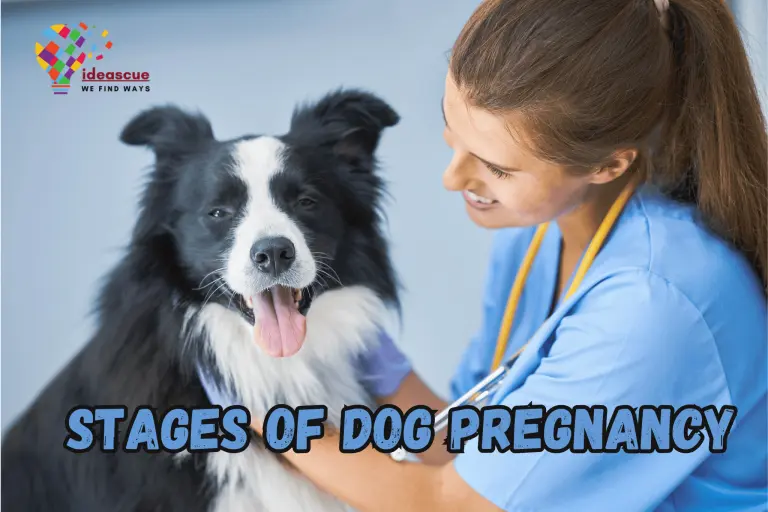How Long are Dogs Pregnant? Stages of Dog Pregnancy Day by Day & Puppy Delivery
Intro:
Dog pregnancy is a fascinating and crucial period in a canine’s life. As a dog owner, by understanding the stages of dog pregnancy day by day, you can ensure proper care and support.
Here, we will break down comprehensive insights into the stages of canine gestation, signs of pregnancy, and care tips. Whether you’re a seasoned breeder of German Shepherds or a first-time dog owner, this will help you simplify the journey of your dog’s pregnancy.

Signs Your Dog Is Pregnant:
Determining if a dog is pregnant involves observing physical and behavioral changes. Early signs include increased appetite, weight gain, and changes in nipple size. As the pregnancy goes on, you might notice more pronounced changes, such as abdominal swelling.
Dog Pregnancy Signs:
- Change in Appetite: Either increased hunger or a lack of interest in food.
- Weight Gain: Noticeable weight gain as the pregnancy progresses.
- Enlarged or Discolored Nipples: Nipples become larger and may change color slightly.
- Behavioral Changes: Increased affection, clinginess, or desire for more alone time.
- Nesting Behaviors: Creating a comfortable area to give birth, often by arranging blankets or bedding.
- Decreased Activity: Less interest in physical activities or appearing more tired than usual.
- Abdominal Enlargement: Visible growth in the abdomen as the puppies develop.
- Morning Sickness: Occasional vomiting or loss of appetite, typically in the early stages.
- Physical Discomfort: Signs of discomfort or restlessness, especially in later stages.
- Increased Body Temperature: Slight increase in body temperature closer to delivery.
- Seeking Quiet Areas: Looking for secluded, quiet spots as the due date approaches.
How Long are Dogs Pregnant?
Dogs, including German shepherd gestation period, lasts about 63 days, or roughly nine weeks. This duration can vary slightly depending on the dog’s breed and size. Knowing the pregnancy timeline is important to offer appropriate care at every stage.
The Reproductive Cycle in Dogs:
The reproductive cycle of a female dog encompasses four stages: proestrus, estrus, diestrus, and anestrus. Each stage displays unique characteristics and hormonal fluctuations, which are essential for understanding breeding and pregnancy in dogs.
Four Stages of Female Dog’s Reproductive Cycle:
- Proestrus: The initial stage, marked by swelling of the vulva and bloody discharge.
- Estrus: The fertile period is when ovulation takes place, and the dog is receptive to mating.
- Diestrus: The stage following mating, characterized by hormonal shifts.
- Anestrus: The resting phase before the cycle repeats.
The Stages of Pregnancy in Dogs:
Stage 1 – Impregnation:
In the first month, the embryos are securely implanted in the uterus. This stage is crucial as the foundations for the spine, organs, and facial features begin to form. By the end of this month, the embryos will have developed into recognizable puppies, albeit at a very early stage. The nutritional needs of the mother start to increase as she supports the growing embryos.
- Slight increase in appetite.
- Mild weight gain.
- Nipples may start to enlarge and become more prominent.
- Some dogs might show signs of morning sickness.
Stage 2 – Month 1 of Pregnancy:
The second month is marked by significant fetal development. The embryos grow rapidly, transforming into fully-formed puppies. During this stage, the critical development of organs, bones, and muscles occurs. The mother’s body undergoes notable changes to accommodate the growing fetuses, and her nutritional requirements will increase substantially to support this rapid growth.
- A clear increase in abdominal size.
- Continued weight gain.
- Movement of puppies may be felt upon touching the abdomen.
- Behavioral changes such as nesting or seeking solitude.
Stage 3 – Month 2 of Pregnancy:
This final stage is the home stretch leading up to birth. The puppies complete their development, growing fur and gaining weight. The mother’s body prepares for labor and delivery. This is a critical time for the mother as her body undergoes significant stress due to the size and weight of the puppies. It’s important to minimize her stress and physical strain during this period.
- Substantial increase in belly size.
- Visible and palpable movement of puppies.
- Nesting behavior becomes more pronounced.
- The dog may become restless or anxious as labor approaches.
Stage 4 – Month 3 of Pregnancy:
Labor begins the final parts of the pregnancy. It’s divided into three stages: the beginning of contractions and dilation of the cervix, the actual delivery of the puppies, and the expulsion of the placentas. This process can last from several hours to up to a day. The mother needs a comfortable, quiet, and safe space for whelping and close monitoring to ensure there are no complications.
- Restlessness and nesting behavior intensify.
- Loss of appetite.
- Visible contractions and straining.
- Appearance of a clear fluid from the vulva, followed by the puppies.
- Discharge of placentas after each puppy is born.
How Long Are Dogs in Labor?
Stage 1: Early Labor
The first stage of labor in dogs marks the beginning of the birthing process, primarily about preparing the body for delivery. During this phase, the cervix dilates, and contractions begin, although they might not be visible externally. This stage can persist for a duration ranging from 6 to 12 hours, sometimes even longer, especially in first-time mothers. The dog may appear anxious or uneasy and might refuse to eat. She’ll likely seek a quiet, secluded spot as her body gears up for the delivery process.
- Pacing, panting, or shivering, indicating discomfort or anxiety.
- Nesting behavior, as the dog prepares a safe place for delivery.
- Loss of appetite or refusal to eat.
- Possible vomiting or clear discharge.
- Visible restlessness and frequent repositioning.
Stage 2: Active Labor
Active labor is when the dog starts to actively push and deliver her puppies. This stage is more obvious, as you’ll see the mother straining and experiencing more noticeable contractions. Each puppy is usually born within a 30-minute to 1-hour interval, but this can vary. The mother will break the amniotic sac (if it hasn’t already broken) and clean the puppies immediately after birth. It’s important to monitor this stage closely to ensure that each puppy is born without complications and that the mother is not in distress.
- Visible contractions and straining.
- Appearance of the water sac, followed by a puppy.
- The mother licks and cleans the puppies as they are born.
- Occasional vocalizations from discomfort.
- Brief periods of rest between the births of puppies.
Stage 3: Delivery of Placentas
The third stage of labor involves the expulsion of the placenta and is often intermingled with Stage 2, as the placenta usually follows the birth of each puppy. The mother might take a rest after each puppy and placenta are delivered, and it’s crucial to ensure that a placenta is expelled for each puppy. Counting the placentas helps to make sure none are retained, which could lead to complications.
- The expulsion of the placenta shortly after each puppy is born.
- The mother may consume the placenta; this is a natural behavior.
- A brief pause in labor before the next puppy begins to emerge.
Stages of Pregnancy in Dogs Week by Week:
In the early stages of dog pregnancy day by day, signs are subtle. From the second to the ninth week, you’ll notice gradual changes in your dog’s body and behavior, including weight gain, increased nipple size, and more pronounced nesting behavior.
Here’s the dog gestation week by week calendar:
Week 1-3:
- Behavioral changes: More affectionate or clingy behavior.
- Appetite changes: Initially reduced, then often increased.
- Nipple growth: Nipples may enlarge and darken.
- Morning sickness: Some dogs experience mild vomiting.
Week 4-6:
- Noticeable weight gain: Belly starts to swell.
- Visible abdominal growth: More pronounced enlargement of the abdomen.
- Movement in the belly: Fetal movements might be felt.
- Coat changes: Some dogs have thicker, shinier coats.
- Nesting behavior begins with preparation for a quiet, comfortable birthing area.
Week 7-9:
- Increased nesting behavior: More pronounced preparation for birth.
- Reduced physical activity: Less interest in exercise.
- Milk production: Nipples may start producing milk.
- Restlessness and discomfort: Signs of approaching labor, like pacing or shivering.
- Appetite loss: Some dogs refuse food as labor nears.
Dogs pregnancy week by week is an essential calendar to take note of. Ensure to write down these signs and see if your dog comes closer to any of these signs. Contact your vet for more information.
How to Care for a Pregnant Dog:
Caring for a pregnant dog involves providing a balanced diet, ensuring a peaceful environment, and avoiding strenuous exercise. As we explore the stages of a dog’s pregnancy, understanding the pregnant female dog’s anatomy is crucial. So regular vet check-ups are pivotal to keeping a close watch on the well-being of the mother and the growing puppies.
How Do You Prepare for a Dog Giving Birth?
Preparing for the birth involves setting up a comfortable whelping area, gathering necessary supplies like towels and a thermometer, and knowing the signs of labor. Being prepared can help ease the birthing process for your dog.
How do Veterinarians Determine if a Dog is Pregnant?
Hormone Tests:
The most common initial test is checking for the hormone relaxin, which is only produced during pregnancy. A blood sample is taken a few weeks after mating. High levels of relaxin confirm pregnancy.
Palpation:
Around 28 to 35 days into the pregnancy, a skilled veterinarian can palpate the dog’s abdomen to feel the developing puppies. This method requires experience, as the fetuses are small and easy to miss.
Ultrasound:
An ultrasound can confirm pregnancy as early as three weeks into gestation and is commonly used around the four to five-week mark. It provides a visual of the developing puppies and can assess the health of the fetuses. Ultrasounds are non-invasive and safe, offering a glimpse of the number of puppies, though not as accurately as an X-ray.
X-Ray:
In the later stages of pregnancy, around week six or later, an x-ray of a pregnant dog is the most accurate method for counting the number of puppies. X-rays can clearly show the skeletal structures of the puppies, but they are typically performed later in the pregnancy to avoid exposing the developing fetuses to harmful radiation.
What to Feed Pregnant Dogs
Pregnant dogs require a nutrient-rich diet with the right balance of proteins, fats, and vitamins. Consult with a vet to tailor a diet plan that meets the specific needs of your dog during pregnancy.

What to Do if Your Dog is Pregnant?
If your dog is pregnant, regular veterinary check-ups are essential. Provide a balanced diet, gentle exercise, and a comfortable environment. Preparing for the birth and knowing what to expect during labor are also key.
How to Help Your Dog in Delivering Her Puppies?
During delivery, provide a calm and clean environment. Monitor for signs of distress and be ready to assist if necessary. Having a vet’s contact information handy is crucial in case of emergencies.
How Do You Take Care of a New Puppy?
After a puppy is born, ensure it is breathing properly and nursing. Keep the environment warm and clean, and monitor both the mother and puppies for any signs of health issues.
Dog Labour Problems and Complications:
Labor complications can include prolonged labor and concern any pet owner. A puppy stuck in the birth canal, or signs of distress in the mother. Immediate veterinary intervention is crucial in these situations to ensure the safety of the mother and puppies.
Signs of Labor Complications:
- Excessive panting or restlessness without progression of labor.
- If labor seems to stop for over two hours, it’s a sign of potential complications.
- Intense vocalization, shaking, or signs of severe pain during labor.
- Straining for more than 30-60 minutes without a puppy being born can indicate a blockage.
- A small amount of discharge is normal, but excessive or continuous flow can be a concern.
- Puppies delivered before full term may not survive or could require intensive care.
- Pieces of the placenta remain inside the uterus after delivery, leading to infection or hemorrhage.
FAQs
Conclusion:
Navigating the stages of dog pregnancy day by day ensures a healthy and safe journey for both the mother and her puppies. It requires attention, care, and understanding of each stage’s unique needs.
By staying informed and prepared, you can provide the best possible environment for your dog’s pregnancy and the arrival of new puppies.
Make sure to visit a vet from time to time to ensure the health of the mother and her puppies remain safe.






